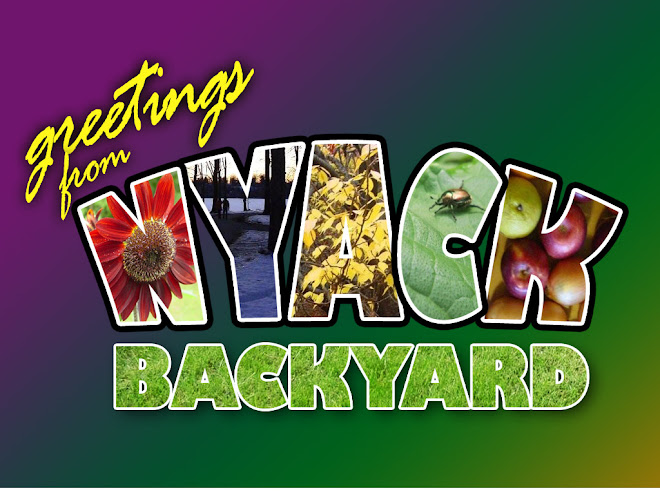Gardening is always a big experiment, and each season teaches us what NOT to do next year. I've only been a member of the Nyack Community Garden for two years, but the first year was very educational for me. Mostly, it was a year of watching other gardeners, observing their techniques, and talking with them about their successes and failures. There's nothing truer than the advice of someone in the plot right next to yours. After all, they're experiencing the same weather, soil and shade that you are -- or at least very close to it! Below are some things I'll be considering as I plant my garden this year.
1) Shade- How much say do you have in which plot you are assigned? Can you choose a plot with more or less shade? Before you plan your plot, visit the garden at different times of day and see where the shade falls. If one side of your plot has a longer sun exposure, put your beans, squash and tomatoes there. Plant lettuces and other less heat-tolerant plants in the shady areas. Consider the shade that you’ll create if you plant tall plants such as sunflowers or teepees and how it might affect your neighbor’s plot.
 |
| The Great Squash Vine Massacre of 2011 |
2) Boundaries – Decide how you’re going to separate your plot from the ones on either side. In our garden, some use wooden boards, trenches, paths, cords, or wire fences. A well-defined border can prevent disputes about weeds and other intrusions.
3) Growing Up/Vines – When you’re short on space, as many community plots are, think about where you can put a trellis or teepee. You may think you don’t have space for squash, but trellising can change that. Another way to save space is by planting bush varieties, helping you avoid what has become known as The Great Squash Vine Massacre of 2011.
4) Weeds – When you don’t weed your plot, you’re not the only one who has to deal with the consequences. Get in there early. Don’t let weeds go to seed in a plot that you’re responsible for – the seeds will travel into your neighbor’s plot and create problems for them, too.
5) Sowing vs. Plants – You might be limited by the dates when your garden opens and closes. For example, you can't get a head start on your peas in March if your garden doesn't open til mid-April. In some cases, it makes more sense to put in plants bought from a nursery rather than sow from seed. When purchasing seeds, be sure to check the number of days to maturity – if it’s long, and your last frost date is late, you might have better luck putting in plants that have had a professional head start.
6) Whimsey – Gnomes anyone? I always appreciate a few pieces of well-chosen décor in my neighbor’s plots – it can help others get a sense of your personality and aesthetic.
7) Mulch – a hotly debated topic in our community garden. Some insisting on plastic weed block, others using straw, wood shavings or nothing at all. Some kind of mulch is helpful in conserving water and preventing weeds.
8) Paths - Often community plots are right next to each other. How will you get around your plot without trampling it? Some options include mulching, trenches, cords, stepping stones, boards. If you opt for boards, be sure they’re not too narrow – it could be hard to get your balance.
9) Pollinators – a plot is never complete without a pollinator plant. Some pretty ones that I’ve noticed making bees very happy are anise hyssop, cleome, and lantana. Think how much healthier the garden will be if every plot includes at least one.
10) Watering – how far are you from the water source and how will you get the water into your plot? Do you have an option to spray or will you hand water with a can? If you’re spraying you might consider putting sturdier plants in front where they won’t be knocked over by forceful sprays.
11)Plant a row – Can you spare a row to help your local food pantry? Our garden club donates an entire plot to this project, sponsored by the Garden Writers Association. Locals can visit this website to find out where your extra fresh vegetables might be needed to help the hungry. For those who aren't local, your cooperative extension can probably point you in the right direction.








7 comments:
nice piece.
We don't have a community plot - we have a plenty big garden and could go bigger - but I'd love for our town to have a community garden and this post is a good resource for things to think about.
w
Those squashes, they died in mid-July sometime? One day they looked great, next day they collapsed? That's the squash borer, which attacks all summer squashes, planting a bush variety will not help.
Thanks W! and anon, the vines were healthy -- too healthy! They completely took over the plot, so I had to take them out. So far I haven't had squash borers in this plot (knock wood)
very thoughtful post. First of all I thought most of this doesn't apply to me because i don't garden on a communal allottment but then i thought we are never an island and we still have neighbours. It's just that they are a bit further away than your neighbouring plot. So communal sharing is wonderful - but when it's food, not weeds!
Hehehe I have to admit sometime I do repeat my mistake which I should have recorded it.
Your article about 11 Things to Think About When Planning a Community Plot is very useful.Very detail and useful
Great things to think about. I'm sure these ideas will be a great help to "first-timers" and vets alike.
Dr Dunc
Post a Comment